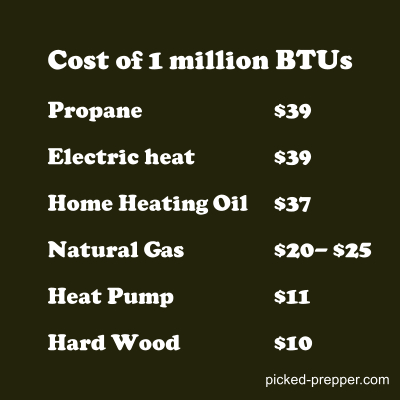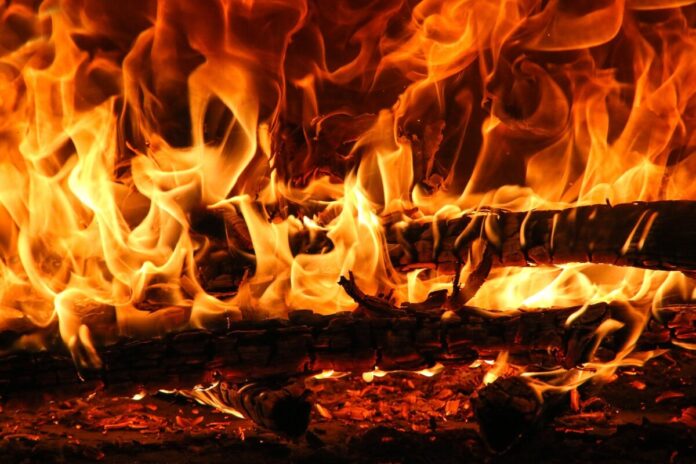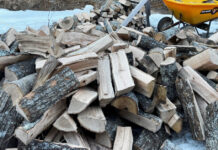In Germany, which is facing a potential natural gas shortage because of the Russian invasion of Ukraine, the powers that be are telling people to set their thermostat to 15 degrees Celsius, about (60 degrees Fahrenheit) and put on a sweater. That echoes what President Carter suggested during the gas shortage in January 1977, when he told all Americans to set the thermostat to 65 and lower at night.
To combat rising fuel prices and potential shortages, I’m going to recommend that you do what my parents did in the 1970s and install a wood-burning stove to heat your house. Not only is it cheaper to burn wood, the quality of radiant heat from a wood stove is better and longer lasting than a forced air heating system.
Besides saving money, a wood stove gives you flexibility and enhances your self-sufficiency. Preppers should have wood heat even if they aren’t worried about the soaring cost of natural gas, propane and home heating oil.
Home Heating Costs
Below are the approximate costs to produce 1 million BTUs of home heat. This is to give you an idea of how much each method costs, but costs will vary by state and may depend on your supplier and what kind of contract you have. These costs do not include any delivery fees, taxes, or the cost of electricity needed to run the fan and pumps in your furnace or boiler.
- A 500 gallon tank of propane, which is filled only to 80 percent or 400 gallons, contains 36 million BTUs. Right now, it would cost $1,400 to fill the propane tank. That works out to about $39 for a million BTUs.

- Electric baseboard heaters and other electric heaters that use resistance cost around $39 per million BTUs, if your cost is 13 cents per kWh. This has traditionally been one of the most expensive home heating methods, but the rising costs of oil and propane make that less true than it once was.
- At $5.13 per gallon, filling a 275 gallon tank of home heating oil also costs $1,400. It provides 38 million BTUs. That’s about $37 per million BTUs, making it slightly more cost effective than Propane on a per-BTU basis.
A million BTUs of natural gas costs residential customers about $20, although it usually rises in the winter, and this year we saw prices around $25. Prices here could increase sharply if U.S. producers ship large amounts of natural gas to Europe.
- To produce 1 million BTUs with an electric heat pump will cost you around $11, as long as the temperatures are above 40 degrees. Once temperatures sink, electrical or propane heating elements kick in, driving up the cost.
Compare the Cost of Firewood
A cord of red oak has 29 million BTUs. I’m paying about $7.75 per million BTUs, but wood is inexpensive in our rural setting; it may cost more in an urban area. If you pay about $300 per cord, that’s $10 per million BTUs. Even if you pay $500 for a cord of mixed hardwood to be delivered and stacked, that’s still cheaper than natural gas.
The economic advantages of wood heat are obvious for anyone who lives where the winter nights frequently drop below 40 degrees. If you are in the Deep South or sunny Southern California, a heat pump will be cost effective but doesn’t help when the power goes out.
Wood Heat can be Inconvenient
Firewood is not a panacea. Having lived with two wood burners for the past two years, I can tell you it is not the most convenient way to heat your house. We like it and don’t plan to change, but here are a few things you will run into:
Heat in Only One Location
If you put a wood stove in your living room, you will be warm and toasty in the living room. The further away you get from the living room, the colder it will get. We enjoy temperatures in the mid 70s in the basement where our wood stove is located, in the low 70s upstairs where the heat rises, and in the low to mid 60s in our bedroom. Since we enjoy sleeping in cool weather and have a nice thick down comforter, this is no problem. The furthest rooms, including the master bath and the guest room, can reach the mid to low 50s. Let’s just say no one will spend much time on the can when it’s 54 degrees in there. Trust me, after a few shivery mornings, your body will adjust.
A properly sized and installed traditional heating system should evenly distribute heat throughout the house. Of course, that may mean you are paying to heat rooms no one uses.
Fires Need Frequent Tending
This depends on the size and efficiency of your stove and the outdoor temperature, but you could find yourself tossing a few logs on the fire anywhere from once every two hours to once every six. We load our stoves up overnight, but there are usually just coals there in the morning and the fire needs to be restarted. It’s rare we need a match, but having some kindling and a bellows helps get things going again.
This also causes problems when we want to go away. Although we are not away from home much, we take some day trips. We have the thermostat for our electric heat pump set at 62. If the fire dies out, the heat pump will kick in when the temperature the main part of the house drops to 62.
I carry ten armloads of five of wood from our outdoor woodpile into the house anywhere from once a week to once every two days when it is below 20 degrees. I would say we average carrying wood in twice a week over the course of a winter.
Wood is Dirty
Our stoves do not emit smoke into the house unless we do something stupid, but carrying wood inside causes dirt and bark fines to magically appear on the carpet. I also spend time with the shop vac every week sucking up pieces of wood and ash around the stove.
While it may be possible to buy barkless oak and find suppliers who never let the wood touch the ground, this ignores the fact that you are bringing part of the outside inside and it will never be as clean as the rest of your house.
Start Now
If you are considering a wood burner, don’t hesitate. Prices are rising as the cost of iron and steel increase, and many suppliers already have waiting lists. Plus, you may need to install or improve your chimney and install some stove pipe. At the very least, you should have your chimney inspected before installing a wood burner and cleaned at least annually.
I also recommend buying your wood now. I already have four cords of wood on site and will have six before summer starts. This allows extra time for the firewood to dry. Even if your supplier tells you they have seasoned wood, an extra six or nine months can only improve it.
I can’t store a year’s worth of propane, but I could store several years’ worth of firewood. I consider having firewood on hand better than having money in the bank because no one is going to tax it or confiscate it and it is tough to steal. Buying it now also ensures you will have a good supply this winter and you won’t be stuck paying more if the price increases.
I stack my wood about four to five feet high and leave it open to the rain, sun and wind all spring and summer. I stack two rows, but I leave at least six inches in between them to allow good air flow. In the fall, at least a month before I anticipate using the wood, I throw a tarp over the wood. The tarp covers the top and a foot or two down the sides and allows any water or melting snow and ice to run off without soaking the wood. You can throw logs on top to keep the tarp from blowing, but I find bungee cords work well.
It’s No-Brainer
Preppers are supposed to be ready for anything and as self-sufficient as possible. Installing a wood stove and stacking firewood wide and deep are a big step forward.
For the serious prepper, the advantages of a wood stove are hard to beat. There are times it can be a hassle, but I spent only $1,100 to heat my house this year. How much did you spend?
I consider the warmth and low cost of wood a worthwhile trade for its inconvenience. Add in the advantages it gives us when the power goes out–either for a few days or a few years–and it’s a no-lose proposition.







